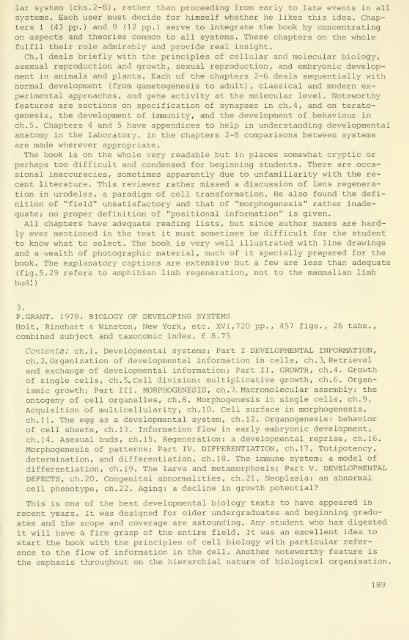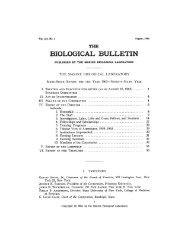General embryological information service - HPS Repository
General embryological information service - HPS Repository
General embryological information service - HPS Repository
You also want an ePaper? Increase the reach of your titles
YUMPU automatically turns print PDFs into web optimized ePapers that Google loves.
lar system (chs.2-8), rather than proceeding from early to late events in all<br />
systems. Each user must decide for himself whether he likes this idea. Chapters<br />
1 (43 pp.) and 9 (12 pp.) serve to integrate the book by concentrating<br />
on aspects and theories common to all systems. These chapters on the whole<br />
fulfil their role admirably and provide real insight.<br />
Ch.l deals briefly with the principles of cellular and molecular biology,<br />
asexual reproduction and growth, sexual reproduction, and embryonic development<br />
in animals and plants. Each of the chapters 2-5 deals sequentially with<br />
normal development (from gametogenesis to adult) , classical and modern experimental<br />
approaches, and gene activity at the molecular level. Noteworthy<br />
features are sections on specification of synapses in ch.4, and on teratogenesis,<br />
the development of immunity, and the development of behaviour in<br />
ch.5. Chapters 4 and 5 have appendices to help in understanding developmental<br />
anatomy in the laboratory. In the chapters 2-8 comparisons between systems<br />
are made wherever appropriate.<br />
The book is on the whole very readable but in places somewhat cryptic or<br />
perhaps too difficult and condensed for beginning students. There are occasional<br />
inaccuracies, sometimes apparently due to unfamiliarity with the recent<br />
literature. This reviewer rather missed a discussion of lens regeneration<br />
in urodeles, a paradigm of cell transformation. He also found the definition<br />
of "field" unsatisfactory and that of "morphogenesis" rather inadequate;<br />
no proper definition of "positional <strong>information</strong>" is given.<br />
All chapters have adequate reading lists, but since author names are hardly<br />
ever mentioned in the text it must sometimes be difficult for the student<br />
to know what to select. The book is very well illustrated with line drawings<br />
and a wealth of photographic material, much of it specially prepared for the<br />
book. The explanatory captions are extensive but a few are less than adequate<br />
(fig. 5. 29 refers to amphibian limb regeneration, not to the mammalian limb<br />
bud!)<br />
3.<br />
P.GRANT. 1978. BIOLOGY OF DEVELOPING SYSTEMS<br />
Holt, Rinehart & Winston, New York, etc. XVI, 720 pp., 457 figs., 26 tabs.,<br />
combined subject and taxonomic index. £ 8.7 5<br />
Contents: ch.l. Developmental systems; Part I DEVELOPMENTAL INFORMATION,<br />
ch. 2. Organization of developmental <strong>information</strong> in cells, ch. 3, Retrieval<br />
and exchange of developmental <strong>information</strong>; Part II. GROWTH, ch.4. Growth<br />
of single cells, ch.5. Cell division: multiplicative growth, ch.6. Organismic<br />
growth; Part III. MORPHOGENESIS, ch. 7. Macromolecular assembly: the<br />
ontogeny of cell organelles, ch.8. Morphogenesis in single cells, ch.9.<br />
Acquisition of multicellularity , ch.lO. Cell surface in morphogenesis,<br />
ch.ll. The egg as a developmental system, ch.l2. Organogenesis: behavior<br />
of cell sheets, ch.l3. Information flow in early embryonic development,<br />
ch.l4. Asexual buds, ch.l5. Regeneration: a developmental reprise, ch.l6.<br />
Morphogenesis of patterns; Part IV. DIFFERENTIATION, ch.l7. Totipotency,<br />
determination, and differentiation, ch.l8. The immune system: a model of<br />
differentiation, ch.l9. The larva and metamorphosis; Part V. DEVELOPMENTAL<br />
DEFECTS, ch.20. Congenital abnormalities, ch.21. Neoplasia: an abnormal<br />
cell phenotype, ch.22. Aging: a decline in growth potential?<br />
This is one of the best developmental biology texts to have appeared in<br />
recent years. It was designed for older undergraduates and beginning graduates<br />
and the scope and coverage are astounding. Any student who has digested<br />
it will have a firm grasp of the entire field. It was an excellent idea to<br />
start the book with the principles of cell biology with particular reference<br />
to the flow of <strong>information</strong> in the cell. Another noteworthy feature is<br />
the emphasis throughout on the hierarchial nature of biological organisation.<br />
189
















